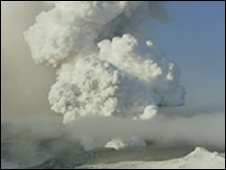Millions of air travellers are stranded as thousands of flights are being cancelled for a third day.
The disruption from the spread of ash would continue into Sunday, European aviation agency Eurocontrol said.
Airlines are losing some £130m ($200m) a day in an unprecedented shutdown of commercial air travel.
"Forecasts suggest that the cloud of volcanic ash will persist and that the impact will continue for at least the next 24 hours," a statement from Eurocontrol said at around 0830 GMT.
The agency, which co-ordinates air traffic control in 38 nations, said it expected 16,000 flights to be cancelled across Europe on Saturday, from a total of 22,000 on a normal Saturday.
Many countries and airlines have grounded fleets as the ash - a mixture of glass, sand and rock particles, drifting from 5,000ft (1,500m) - can seriously damage aircraft engines.
Some 18,000 of the 28,000 daily flights in the affected zone were cancelled on Friday, twice as many as the day before.
The UK extended its ban on commercial flights until at least 0700 local time (0600 GMT) on Sunday.
Many other countries, from Ireland to Russia, have also closed their airspace. In northern France and northern Italy, airports are shut until Monday.
The disruption has now affected millions of travellers since Wednesday when the Eyjafjallajoekull volcano began erupting for the second time in a month.
Scientists in Iceland said they hoped to fly above the volcano to assess how much ice has melted, now that winds have cleared visibility.
A plume of ash 8.5km (5.3 miles) high was visible on Saturday.
A "significant quantity" of ash was contained in the column, said Dr David Rothery, of the UK Open University's earth sciences department, based on live images from webcams in Iceland.
"The column is pulsing in height, as fresh explosions occur in the active crater. One can see curtains of ash fallout below the plume from time to time," he said.
According to Mr Rothery, the fine ash at the top of the column is likely to be drawn into the high altitude winds, adding to the ash cloud heading southwards across the continent.
Long way home
Europe's busiest airports, including Heathrow in London, Frankfurt and Charles de Gaulle in Paris, have been affected by the closures.
"There has never been anything like this," he said, adding that there were no Lufthansa planes in the air anywhere in the world.
Unable to catch flights, commuters across northern Europe have sought other means of transport, packing out trains, buses and ferries.
The Eurostar cross-channel rail service said it had never seen so many passengers on one day and the trains were fully booked until Monday.
The large no-fly zone also means that some world leaders might have difficulty attending the funeral of the Polish president on Sunday.
German Chancellor Angela Merkel, who was due to return from a visit to the US on Friday, had to fly to Lisbon where she spent the night.
With all German airports still closed, she flew on to Italy on Saturday and is set to continue her journey home by bus.
The disruption also forced the cancellation of the inaugural Iraqi Airways flight from Baghdad to London.
US pop star Whitney Houston was forced to take a car ferry from Britain to Ireland for a concert after her flight was cancelled.
The travel chaos has been felt as far away as North America and Asia, with dozens of Europe-bound flights being cancelled.
British health officials said any effects of the ash on people with existing respiratory conditions were "likely to be short term".
The last eruption of the Eyjafjallajoekull volcano was on 20 March, when a 0.5km-long fissure opened up on the eastern side of the glacier at the Fimmvoerduhals Pass. The eruption prior to that started in 1821 - and continued intermittently for more than a year.
Iceland lies on the Mid-Atlantic Ridge, the highly volatile boundary between the Eurasian and North American continental plates.
 Virtually all of Europe's major airports remain closed as a huge plume of volcanic ash drifts south and east across the continent from Iceland.
Virtually all of Europe's major airports remain closed as a huge plume of volcanic ash drifts south and east across the continent from Iceland.


